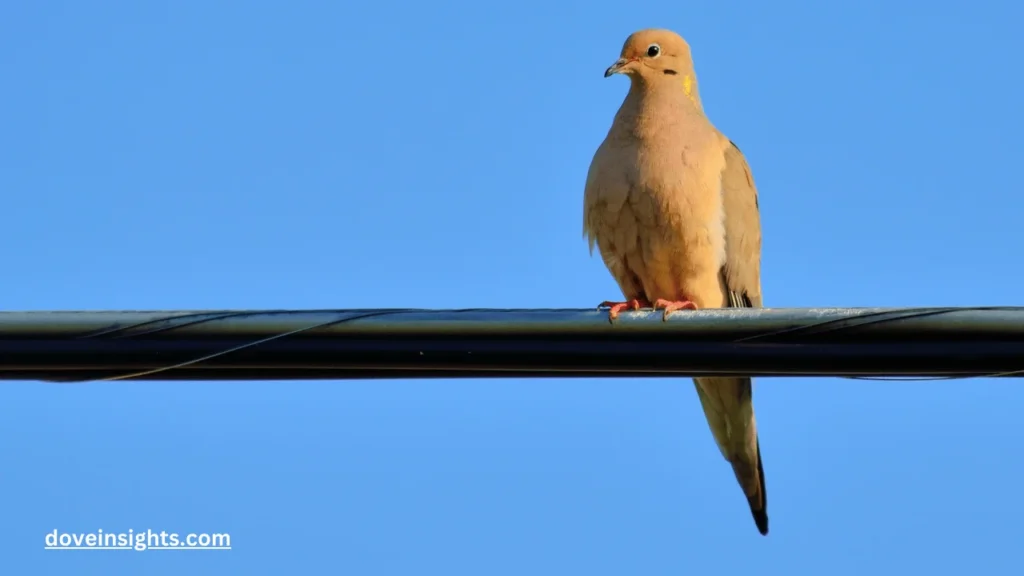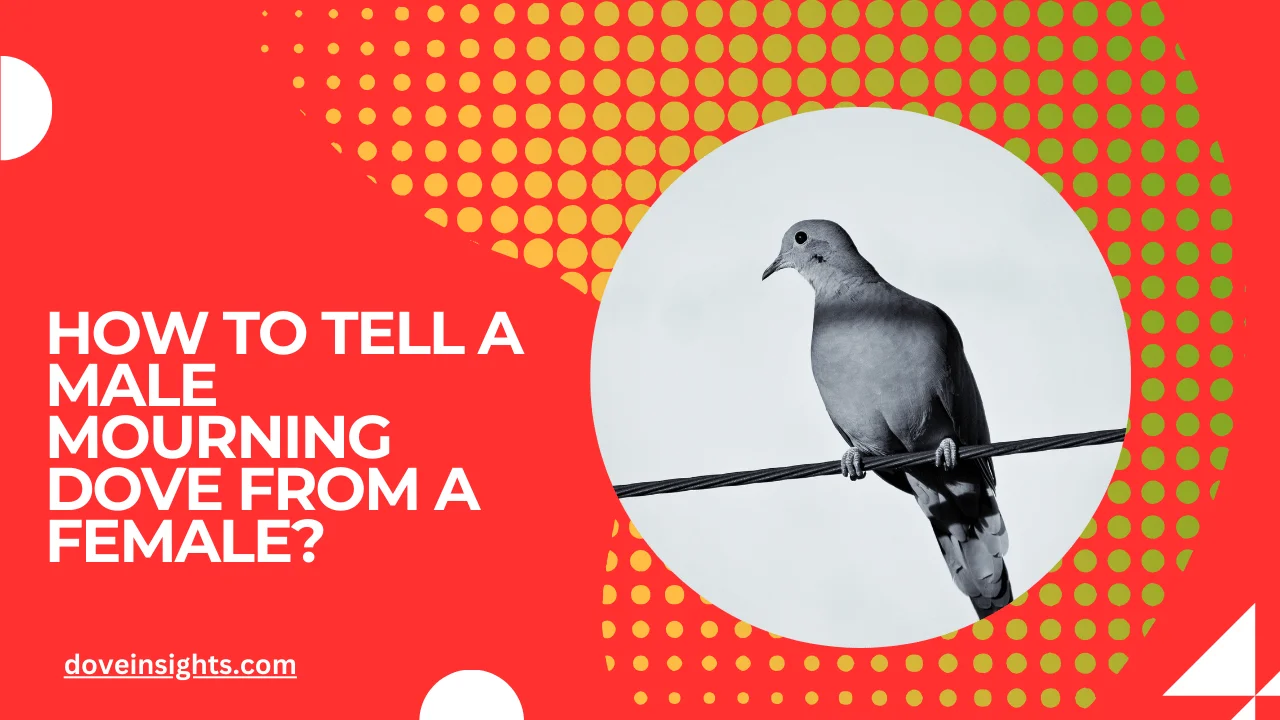The mourning dove, with its soft gray feathers, gentle cooing, and graceful flight, is one of the most common and beloved birds in North America.
These peaceful creatures are often seen in backyards, perched on power lines, or soaring across the sky. While their beauty and tranquil nature may capture our attention, there’s an often-overlooked aspect of mourning doves that might spark curiosity: how do you tell a male mourning dove from a female?
At first glance, these birds may seem almost identical, with their subtle coloration and delicate features. However, despite the outward similarities, there are some important and distinctive characteristics that differentiate the male from the female.
Understanding these differences is not only fascinating but also valuable for birdwatchers, nature enthusiasts, and those interested in bird behavior. Whether you’re trying to identify the pair of mourning doves in your garden or curious about their reproductive habits, this article will guide you through the key indicators to help you tell the males from the females.
While these differences can be quite subtle, paying attention to behavior, physical traits, and sounds will make the identification process easier.
By the end of this article, you’ll be able to confidently distinguish between a male and female mourning dove and understand the important roles each plays in the bird’s life cycle.
Contents
- 1 Physical Differences Between Male and Female Mourning Doves
- 2 Behavioral Differences Between Male and Female Mourning Doves
- 3 The Role of Sound in Gender Identification
- 4 Understanding the Role of Physical and Behavioral Traits in Their Social Structure
- 5 How to Tell a Male from a Female in the Wild
- 6 Conclusion
- 7 FAQ’s
- 7.0.1 Can I tell the difference between a male and female mourning dove from a distance?
- 7.0.2 Do mourning doves have different behaviors during breeding season?
- 7.0.3 How can I tell if a mourning dove is male or female just by looking at the plumage?
- 7.0.4 Do mourning doves mate for life?
- 7.0.5 How long does it take for mourning dove eggs to hatch?
- 7.0.6 Do male and female mourning doves share parenting duties?
Physical Differences Between Male and Female Mourning Doves
One of the easiest ways to tell a male mourning dove from a female is by looking at their physical characteristics. Though both sexes share the same general appearance, there are a few key differences that can help you identify them.
- Size: The male mourning dove is slightly larger than the female. Males tend to have a more robust and longer body, while females are a bit more compact and petite. This size difference is subtle but noticeable if you observe both birds together.
- Coloration and Markings: Although both males and females have similar grayish-brown feathers, males typically have slightly darker and more vibrant plumage. Males often exhibit richer shades of gray on their wings and tail feathers, while females may have more muted or dull colors. Males may also have a more prominent blackish spot on their neck, which can be faint in females.
- Eye Color: Another important physical difference is the color of the eyes. Males generally have darker eyes, while females tend to have eyes that appear a bit lighter or more reddish-brown. This difference can be subtle and harder to spot unless you get a close-up view, but it can be a helpful indicator when trying to distinguish between the sexes.
Behavioral Differences Between Male and Female Mourning Doves
In addition to physical traits, mourning doves also exhibit distinctive behaviors that can help you tell a male from a female. While both birds share some of the same habits, there are certain actions and tendencies that are more common to one sex than the other.
- Courtship and Mating Rituals: During the breeding season, males engage in more elaborate courtship behaviors to attract a mate. The male will perform a unique bowing display, puffing up his chest, and making cooing sounds to show his interest. This behavior is not only a signal of courtship but also serves to demonstrate the male’s strength and suitability as a mate. Females, on the other hand, are more passive during the courtship process and will often just watch the male from a distance before deciding to mate.
- Feeding and Foraging: While both sexes forage for food, males are generally seen foraging in open areas, while females may be more likely to feed in secluded spots. Males also tend to be more dominant at feeding sites, asserting their territorial behavior and chasing other birds away. Females, by contrast, are typically less aggressive and more focused on nurturing their offspring once they’ve mated.
- Parental Duties: Once the eggs are laid, both the male and female share in incubating the eggs. However, males are often more vocal and territorial during the nesting period, defending their nesting site from potential threats. Females, on the other hand, are primarily focused on keeping the nest safe and warm while incubating. They are usually the primary caregivers to the chicks once they hatch.
The Role of Sound in Gender Identification
The sound of mourning doves is one of their most defining characteristics, and it can also serve as a clue to help you identify a male from a female. The cooing call of mourning doves is often heard during the day, but the pattern and style of the cooing differ slightly between the sexes.
- Male Calls: The male mourning dove produces the deep, repetitive “coo-COO-coo” sound. This call is often louder and more persistent, especially during the breeding season when the male is trying to attract a mate or defend his territory. The tone and frequency of the male’s call are usually stronger and more pronounced compared to that of the female.
- Female Calls: Female mourning doves typically make a softer, less frequent cooing sound. Their calls are often more gentle and less dominant compared to the male. While the female does participate in calling, her sounds are more about communication with the male or signaling her presence, rather than asserting territory.
Paying attention to the sound patterns during the mating season can make it easier to identify the sex of the bird based on the volume, tone, and frequency of their calls.
Understanding the Role of Physical and Behavioral Traits in Their Social Structure
Mourning doves have an interesting social structure, and their behaviors are closely tied to their roles in the ecosystem. Understanding how males and females behave in relation to each other can help solidify your ability to differentiate between the sexes.
- Male Dominance: Males are typically more dominant in their behavior, especially when it comes to defending territory or attracting mates. They will often be the ones seen engaging in display rituals, puffing up their chests, and flying in circles to impress females. These behaviors signal the male’s fitness and readiness to mate. While the female may engage in courtship to some extent, it’s the male who takes the lead in initiating mating rituals.
- Female Role: In contrast, females are more likely to exhibit nurturing behaviors and are less aggressive when it comes to defending their territory. Their role is focused on choosing a mate, incubating eggs, and raising chicks. The female’s behavior tends to be less showy and more focused on her immediate surroundings, providing care for her young once the eggs hatch.
How to Tell a Male from a Female in the Wild

In the wild, identifying the gender of a mourning dove can be a bit more challenging, especially when you don’t have access to close-up views. However, there are some key signs you can look for to help with identification.
- Behavioral Cues: Observe the male’s courtship behavior—if you see one dove puffing up and bowing while making louder, more frequent calls, it’s likely a male. Additionally, males are often more territorial and visible during the breeding season. Females, on the other hand, may be seen feeding or nesting in quieter areas.
- Nesting and Mating Season: During the mating season, males will often be more active around the nest, while females take a quieter role in the process. If you observe a dove sitting on a nest for long periods, chances are it’s a female, though the male will also be nearby, keeping a watchful eye on the surroundings.
Conclusion
Telling a male mourning dove from a female may seem like a simple task, but there are many subtle nuances to consider.
By paying attention to physical characteristics, behavioral traits, and sound patterns, you can easily differentiate between the sexes and gain a deeper understanding of their roles in the natural world.
Whether you’re a seasoned birdwatcher or a newcomer to the fascinating world of doves, these insights will enhance your ability to appreciate the intricate behaviors of these beautiful creatures.
From the size and coloration to the cooing sounds and courtship displays, male and female mourning doves exhibit distinct traits that reflect their roles in reproduction and social structure.
By learning how to tell the males from the females, you’ll be able to observe and appreciate these birds with a new level of knowledge and respect.
FAQ’s
Can I tell the difference between a male and female mourning dove from a distance?
Yes, while it can be difficult to identify them from far away, you can often tell the difference by observing certain behaviors and traits. Males are typically more dominant and visible during courtship and territorial defense, while females tend to be more passive and may stay closer to the nest. The male’s cooing call is also louder and more frequent, which can help in identification.
Do mourning doves have different behaviors during breeding season?
Yes, during breeding season, males exhibit distinctive courtship displays, such as puffing up their chests and bowing, while making louder and more frequent cooing sounds. This is their way of attracting a mate and defending territory. The female, on the other hand, is more passive, primarily focusing on choosing a mate and caring for the eggs once laid.
How can I tell if a mourning dove is male or female just by looking at the plumage?
While both sexes share similar coloration, males typically have darker, more vibrant feathers with richer shades of gray. Females usually have more muted or duller tones. The male’s neck might also have a more prominent blackish spot, while the female’s spot is usually smaller or absent. The eye color can also provide a clue: males have darker eyes, while females may have eyes that appear slightly lighter or reddish-brown.
Do mourning doves mate for life?
Mourning doves generally form monogamous pairs for the breeding season, and in some cases, these pairs may stay together for multiple seasons. However, they do not typically mate for life. Once the breeding season ends, doves may separate, with new mates chosen in the following seasons. Both males and females are highly involved in raising the young during the breeding season.
How long does it take for mourning dove eggs to hatch?
Mourning dove eggs typically hatch after about 14 to 15 days of incubation. Both the male and female take turns incubating the eggs. Once the chicks hatch, both parents continue to care for and feed them until they are ready to leave the nest, which usually occurs around 12 to 18 days after hatching.
Yes, both the male and female mourning dove share parenting responsibilities. While the female usually incubates the eggs at night, the male takes over during the day. After the eggs hatch, both parents are involved in feeding and protecting the chicks until they are independent.








